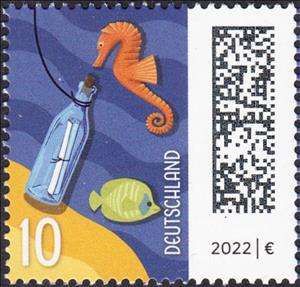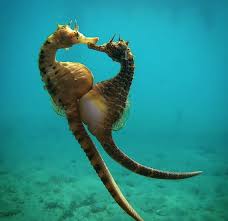Stamp: Letter in a Bottle (Germany, Federal Republic 2022)
Letter in a Bottle (Germany, Federal Republic 2022)
02 November (Germany, Federal Republic ) within release World of the Letter Definitives (2021-) goes into circulation Stamp Letter in a Bottle face value 10 Euro cent
| Stamp Letter in a Bottle in catalogues | |
|---|---|
| Michel: | Mi: DE 3723 |
| Colnect codes: | Col: DE 2022.11.02-01 |
Stamp is horizontal format.
Issued in both panes of 10 and coils of 200Also in the issue World of the Letter Definitives (2021-):
- Stamp - Letter in a Bottle face value 10;
- Full Pane - Letter in a Bottle face value 10*10;
- Stamp - Letter in a Bottle face value 10;
- Stamp with Attached Label - Letter in a Bottle face value 10;
- Gutter Pairs - Letter in a Bottle face value 2*10;
- Stamp with Attached Label - Letter in a Bottle face value 10;
- Stamp - Letter in a Bottle face value 10;
- Stamp with Attached Label - Letter in a Bottle face value 10;
- Gutter Pairs - Letter in a Bottle face value 2*10;
- Gutter Pairs - Letter in a Bottle face value 2*10;
- Stamp with Attached Label - Letter in a Bottle face value 10;
- Stamp with Attached Label - Letter in a Bottle face value 10;
- Gutter Pairs - Letter in a Bottle face value 2*10;
- Stamp with Attached Label - Letter in a Bottle face value 10;
- Stamp - Letter in a Bottle face value 10;
- Stamp - Letter in a Bottle face value 10;
- Stamp with Attached Label - Letter in a Bottle face value 10;
- Gutter Pairs - Letter in a Bottle face value 2*10;
- Stamp with Attached Label - Letter in a Bottle face value 10;
- Stamp - Letter in a Bottle face value 10;
- Stamp - Letter in a Bottle face value 10;
- Stamp - Letter in a Bottle face value 10;
- Stamp with Attached Label - Letter in a Bottle face value 10;
- Gutter Pairs - Letter in a Bottle face value 2*10;
- Stamp with Attached Label - Letter in a Bottle face value 10;
- Gutter Pairs - Letter in a Bottle face value 2*10;
- Stamp with Attached Label - Letter in a Bottle face value 10;
Stamp Letter in a Bottle it reflects the thematic directions:
First attested in 14th century. From the English word bottle derives from an Old French word boteille, from vulgar Latin butticula, from late Latin buttis ("cask"), a latinisation of the Greek βοῦττις (bouttis) ("vessel"
A fish is any member of a group of animals that consist of all gill-bearing aquatic craniate animals that lack limbs with digits. They form a sister group to the tunicates, together forming the olfactores. Included in this definition are the living hagfish, lampreys, and cartilaginous and bony fish as well as various extinct related groups. Tetrapods emerged within lobe-finned fishes, so cladistically they are fish as well. However, traditionally fish are rendered obsolete or paraphyletic by excluding the tetrapods (i.e., the amphibians, reptiles, birds and mammals which all descended from within the same ancestry). Because in this manner the term "fish" is defined negatively as a paraphyletic group, it is not considered a formal taxonomic grouping in systematic biology. The traditional term pisces (also ichthyes) is considered a typological, but not a phylogenetic classification. The earliest organisms that can be classified as fish were soft-bodied chordates that first appeared during the Cambrian period. Although they lacked a true spine, they possessed notochords which allowed them to be more agile than their invertebrate counterparts. Fish would continue to evolve through the Paleozoic era, diversifying into a wide variety of forms. Many fish of the Paleozoic developed external armor that protected them from predators. The first fish with jaws appeared in the Silurian period, after which many (such as sharks) became formidable marine predators rather than just the prey of arthropods. Most fish are ectothermic ("cold-blooded"), allowing their body temperatures to vary as ambient temperatures change, though some of the large active swimmers like white shark and tuna can hold a higher core temperature. Fish are abundant in most bodies of water. They can be found in nearly all aquatic environments, from high mountain streams (e.g., char and gudgeon) to the abyssal and even hadal depths of the deepest oceans (e.g., gulpers and anglerfish). With 33,100 described species, fish exhibit greater species diversity than any other group of vertebrates. Fish are an important resource for humans worldwide, especially as food. Commercial and subsistence fishers hunt fish in wild fisheries (see fishing) or farm them in ponds or in cages in the ocean (see aquaculture). They are also caught by recreational fishers, kept as pets, raised by fishkeepers, and exhibited in public aquaria. Fish have had a role in culture through the ages, serving as deities, religious symbols, and as the subjects of art, books and movies.
A seahorse (also written sea-horse and sea horse) is any of 46 species of small marine bony fish in the genus Hippocampus. "Hippocampus" comes from the Ancient Greek hippókampos (ἱππόκαμπος), itself from híppos (ἵππος) meaning "horse" and kámpos (κάμπος) meaning "sea monster" or "sea animal".Having a head and neck suggestive of a horse, seahorses also feature segmented bony armour, an upright posture and a curled prehensile tail. Along with the pipefishes and seadragons (Phycodurus and Phyllopteryx) they form the family Syngnathidae.



